Real Madrid remain without a win on the road since Zinedine Zidane was appointed as manager for a second time, yet their humiliating defeat at the hands of Real Sociedad on Sunday evening was arguably their worst performance yet as they continue to disappoint while Zidane experiments.
The evening got off to a perfect start as Brahim Díaz opened the scoring with a stunning goal on six minutes but it was all downhill from there. Mikel Merino was picked out by Igor Zubeldía and a fine passing move allowed him to level the tie. This was before Jesús Vallejo was sent off for a magnificent save with his hands as the last man. Willian José missed the resulting penalty but Joseba Zaldúa gave the hosts the lead in the second half, finding space at the far post to send a looping header beyond Thibaut Courtois.
Mikel Oyarzabal exploited the same weakness on Marcelo’s side of defence minutes later, rocketing a shot against the post only for Ander Barrenetxea to poke home the rebound, allowing the 17-year-old to become the youngest player ever to score against Real Madrid in La Liga.
Our tactical analysis will use statistics to identify what key points Zidane can take from the game as his Real Madrid team were beaten again.
Lineups
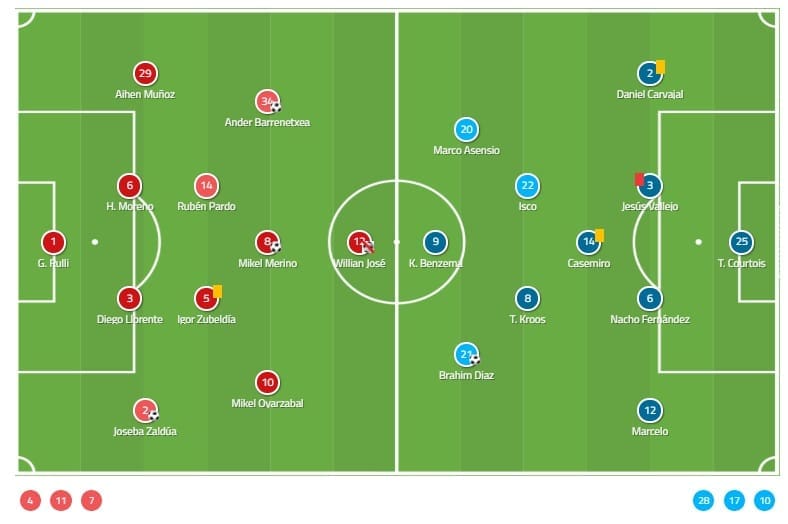
Just a fourth La Liga start for Barrenetxea was perhaps the only surprise in the Real Sociedad line-up, with Willian chosen to lead the line and Juanmi left on the bench.
The major headline pre-match was the absence of Gareth Bale from Real Madrid‘s squad entirely, with Brahim given the starting spot that he may otherwise have occupied. After his impressive form of late, Vallejo was given another chance in defence and Isco was selected ahead of Luka Modrić in midfield.
Real Sociedad targeted Real Madrid’s weak point
Real Sociedad’s three goals all came through one clear tactic and approach: coming in central to attack from wide areas. The style was clear in that Real Sociedad would bring the ball to the final third through the middle, then quickly spread the ball out wide to stretch the Real Madrid defence. With this achieved, often with one of the Madrid full-backs caught too high up the field, they would look to exploit the space in between the central defenders and the full-backs to find a route through to goal, with playmakers like Oyarzabal and Zubeldía being able to pick out the passes.
That was exactly the case for the opening goal in particular, where it was clear that the backline combination of Real Madrid have rarely played together and lacked the fluidity and communication of a regular back four. Marcelo was slow to get back, meaning that Nacho drifted to the left and required Vallejo to move across to cover his man before the ball spread to the right and Carvajal was forced out wide. With Casemiro covering for the lack of men on the right, Merino was able to get into the box between Carvajal and Vallejo with all the time in the world to set himself up for a shot after a neat one-two to create a yard of extra space as Vallejo caught up with play.
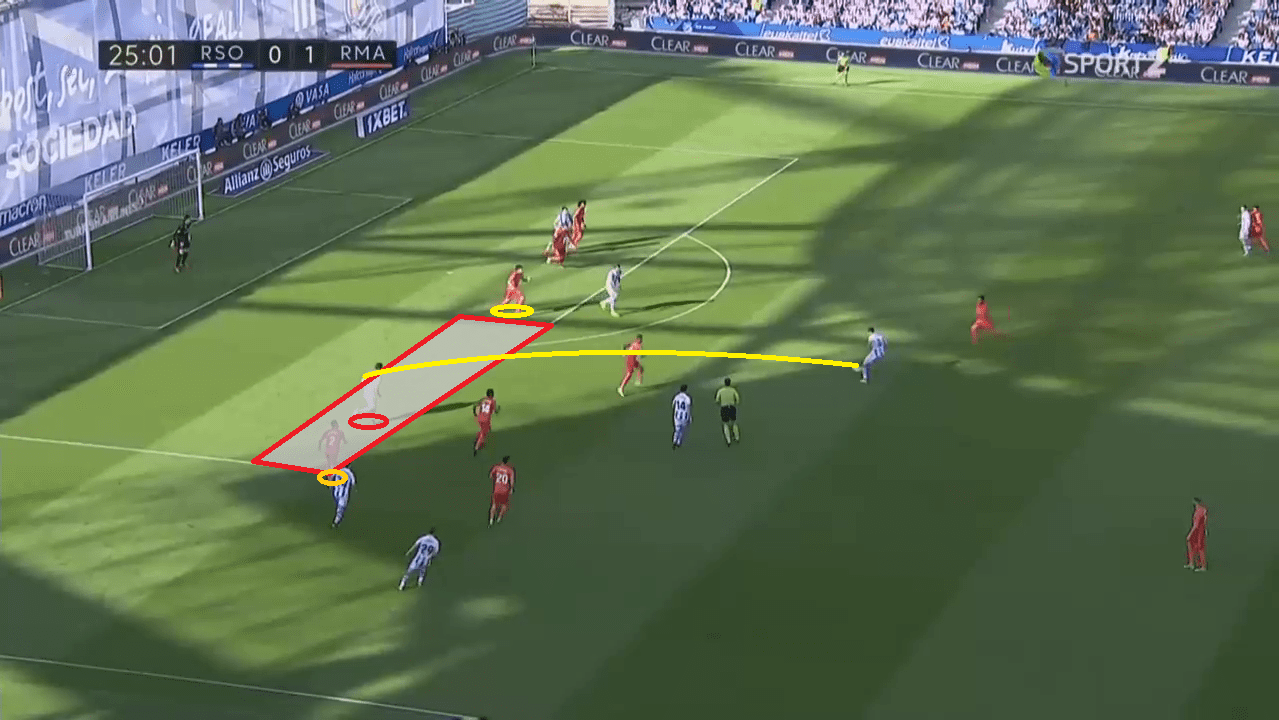
Real Madrid’s poor defensive structure has repeatedly come back to haunt them this season and teams have continually targeted them from the wide areas. Real Sociedad’s approach was an interesting one as it particularly focused upon the area where Raphael Varane and Sergio Ramos have provided cover for much of the season, masking some of the issues created by the lack of discipline on the flanks. The result was a clear win for Real Sociedad whilst Real Madrid just couldn’t find the solution, even when Zidane dropped his wide men deeper after the red card.
Casemiro at the back failed
The other change that followed Vallejo’s dismissal was an enforced one as Casemiro dropped into the central defensive role given that Zidane had opted to only select four defenders for his matchday squad. However, if anything, it only worsened the problem.
The Brazilian operated almost as a sweeper, looking to cover in behind Nacho and make last gasp clearances, something he did four times, rather than looking to operate alongside him as part of a four-man unit. That led to him being very narrow and tight to his central partner, effectively opening up the spaces with the full-backs even more.
Without the defensive presence in midfield ahead of him, nobody dropped back to become a third central defender in the way that he often does either, exacerbating the problem wildly. Modrić and Toni Kroos both attempted to take up the role at times but did not drop deep enough, instead operating more like a second back of four as opposed to actually taking up the role of a defensive midfielder. Surprisingly, at no point did Zidane look to take attention away from Willian, who was kept quiet successfully, but at the expense of leaving huge vulnerabilities out wide.
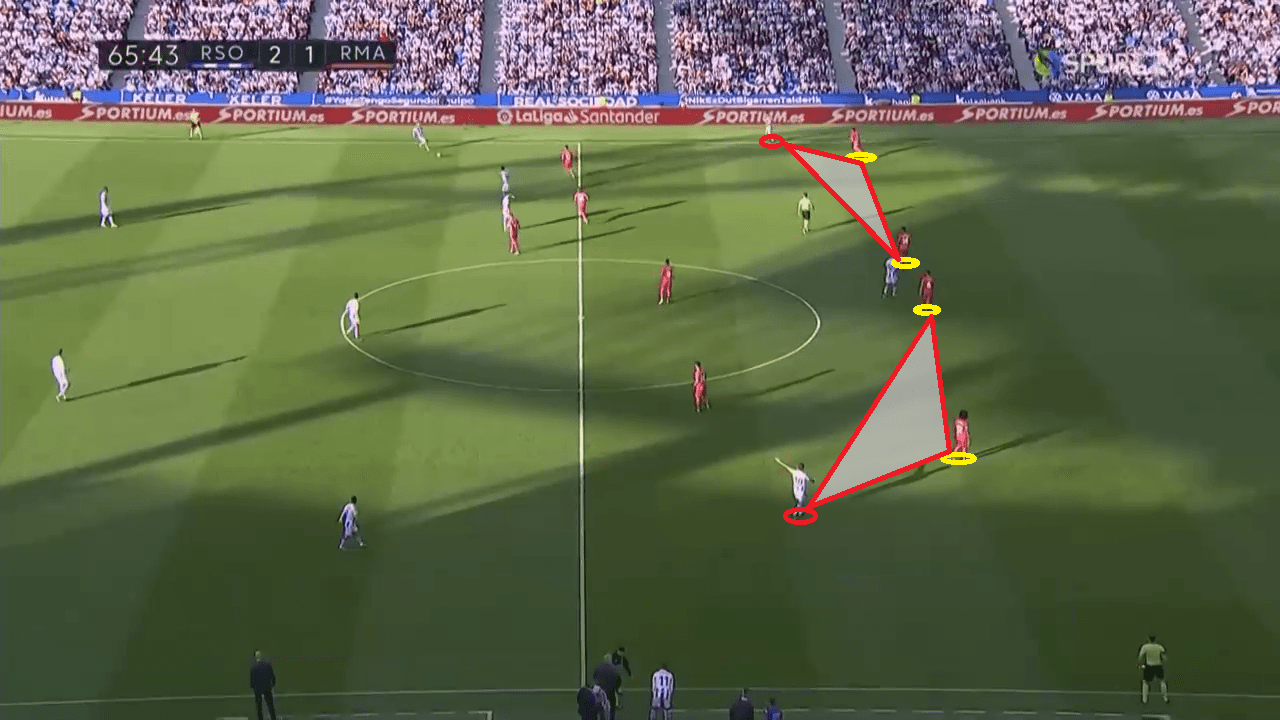
With just one success in his 13 defensive duels, the problems were not just limited to positioning. Casemiro, despite his defensive excellence in midfield, has never looked at home playing in the backline and it was no different in San Sebastian on Sunday. Time after time, he looked lost and was diving into challenges that he would usually hold off on, then suddenly freezing in the box in fear of conceding a penalty and not putting his foot in. During one second-half spell, he committed three fouls in just 10 minutes, unsurprisingly leading to a yellow card and just going to show his discomfort in the role.
No attacking threat
December 2015 was the last time that Real Madrid achieved fewer than two shots on goal, a tally only recorded twice since then before Sunday’s defeat. With just 0.49 xG, it was Real Madrid’s second lowest of the season, beaten only by the 0.3 from a 0-1 win over relegated Huesca in December 2018. Goals have been a source of frustration all season long following Cristiano Ronaldo’s departure, but this outing was one of the bluntest and most ineffective of the whole campaign as Zidane failed to come up with an alternative, particularly following the sending off of Vallejo.
The result was that the two wide men, Brahim and Marco Asensio, dropped deeper almost to become wide midfielders. That meant that Benzema would become hugely isolated in attack, usually only being joined by one of his wide men if either. Outnumbered massively, his hold-up play was brave but not enough to bring others into the game. The result was that the Frenchman made just one single pass in the final third throughout the 90 minutes, receiving 21 passes, his lowest figure since the Clasico defeat in La Liga in early March.
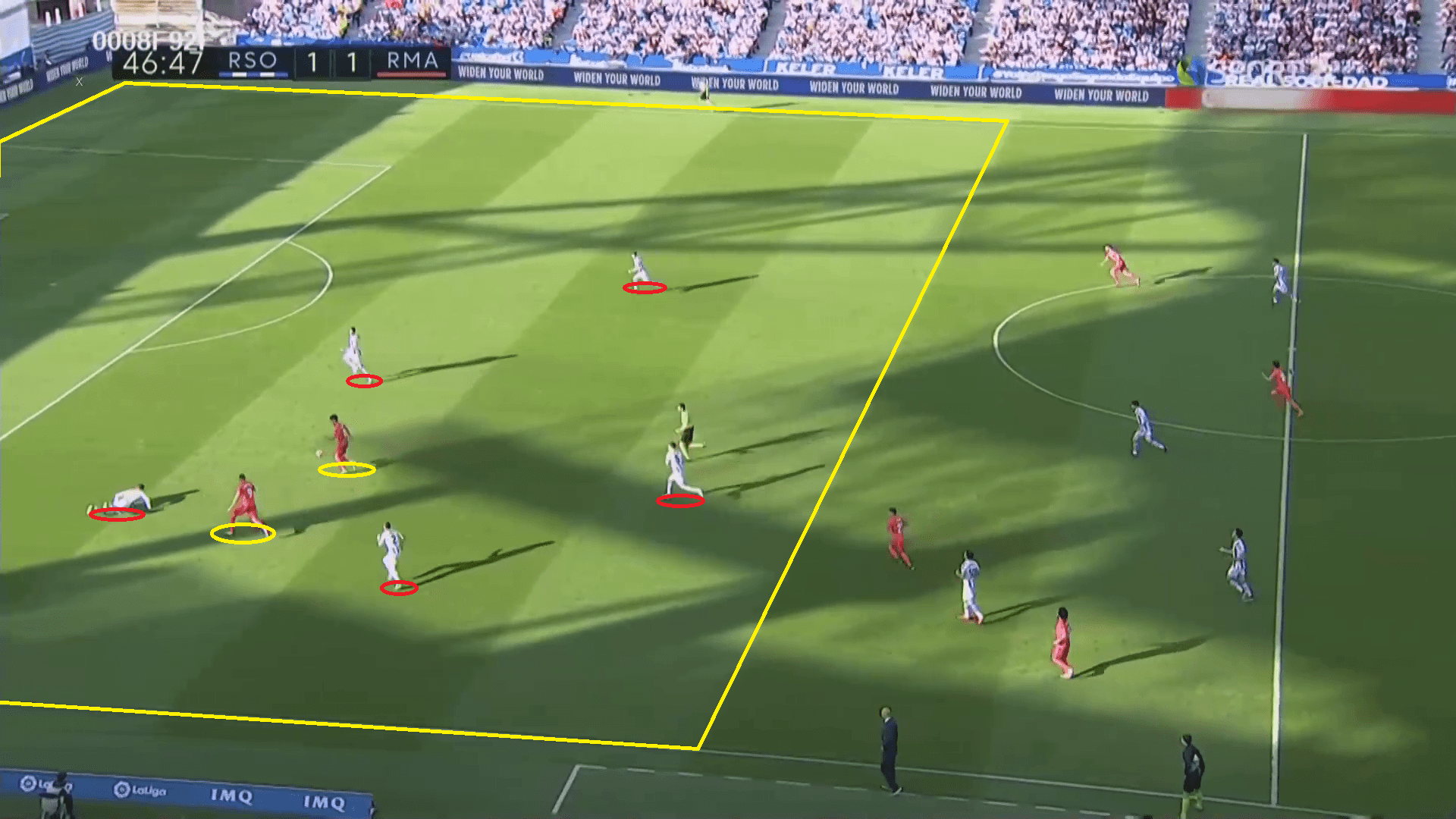
Even when he was joined, the two attackers would be so heavily outnumbered by a Real Sociedad defence who wouldn’t have complained about a draw where they couldn’t make an impact. The best example came early in the second half when Diego Llorente’s slip played the ball to Asensio, though he and Benzema were so close together that the Frenchman couldn’t offer an option and no-one else could catch up with play starting from such a deep position. The Spaniard was left with no choice but to shoot and have his effort blocked easily in a move which summed up the display.
Brahim: The glimmer of hope?
There weren’t many reasons to be positive on Sunday but one was yet another dazzling display from Brahim Díaz. Talks about a potential loan move next season continue, but in his latest outing he once again proved to be a crucial piece of the puzzle for Zidane as he showed the kind of bravery and confidence that has been so lacking in this side, particularly without Vinicius Junior as he continues to work his way back from injury. In the sixth minute, he scored a magnificent goal which started with collecting the ball 40 yards out from goal.
Having shrugged off one challenge, he was faced with the option of going wide, playing an easy pass or taking on Diego Llorente who was being covered by Hector Moreno in behind. Rather than shift the ball quickly, he took on Llorente, then preceded to beat Moreno and leave him for dead, cutting back inside to take a shot and smash the ball beyond Gerónimo Rulli. It was just one of five progressive runs and six successful dribbles which saw the former Manchester City youngster get Real Madrid fans on the edge of their seat. He was almost the only player to do that at all on Sunday.
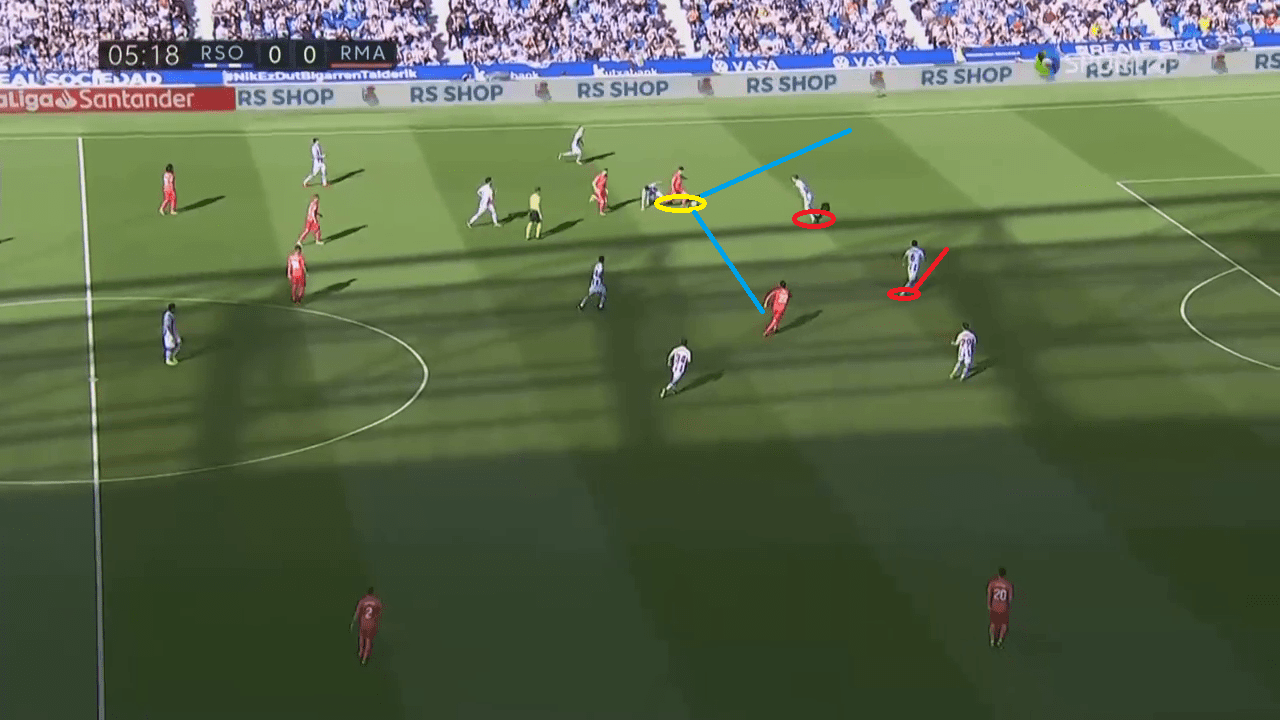
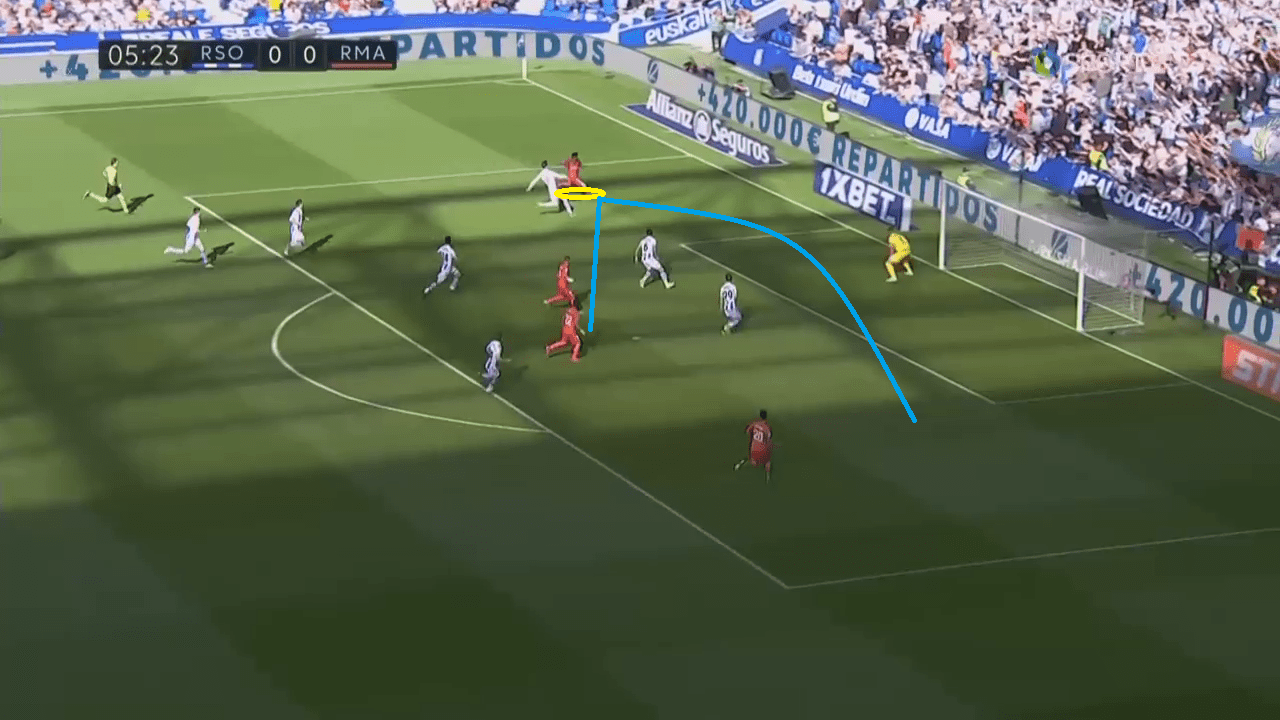
Quite what role he has to play remains a mystery given persistent speculation about Eden Hazard’s potential arrival, Rodrygo Goes finally joining the club this summer, Vinicius’ return from injury and continued doubts over whether Bale will actually be sold. A loan may be the best route to earn him regular first-team football and a greater shot at consistency, but Real Madrid fans rarely take too kindly to seeing exciting youngsters forced out of the club unless there is a big name to replace them.
Conclusion
Real Madrid’s woes continue to be rooted in their defensive issues and their lack of attacking depth, rather than an ageing midfield or the need for a world-class first choice number nine. As Zidane experiments, these problems are only becoming clearer with every passing week as the team fails to resolve basic issues such as defensive structure which leaves them open to vulnerabilities. Whilst Brahim has shown confidence, few others show the same kind of bravery or guts on the road to take their men on or gamble on playing an incisive pass and it’s beginning to show as the lack of incision leads to few chances. There is work to do for Zidane this summer, but his problems are deep-rooted and lie in work on the training ground just as much, if not more, than in the transfer market.
If you love tactical analysis, then you’ll love the digital magazines from totalfootballanalysis.com – a guaranteed 100+ pages of pure tactical analysis covering topics from the Premier League, Serie A, La Liga, Bundesliga and many, many more. Buy your copy of the May issue for just ₤4.99 here, or even better sign up for a ₤50 annual membership (12 monthly issues plus the annual review) right here.

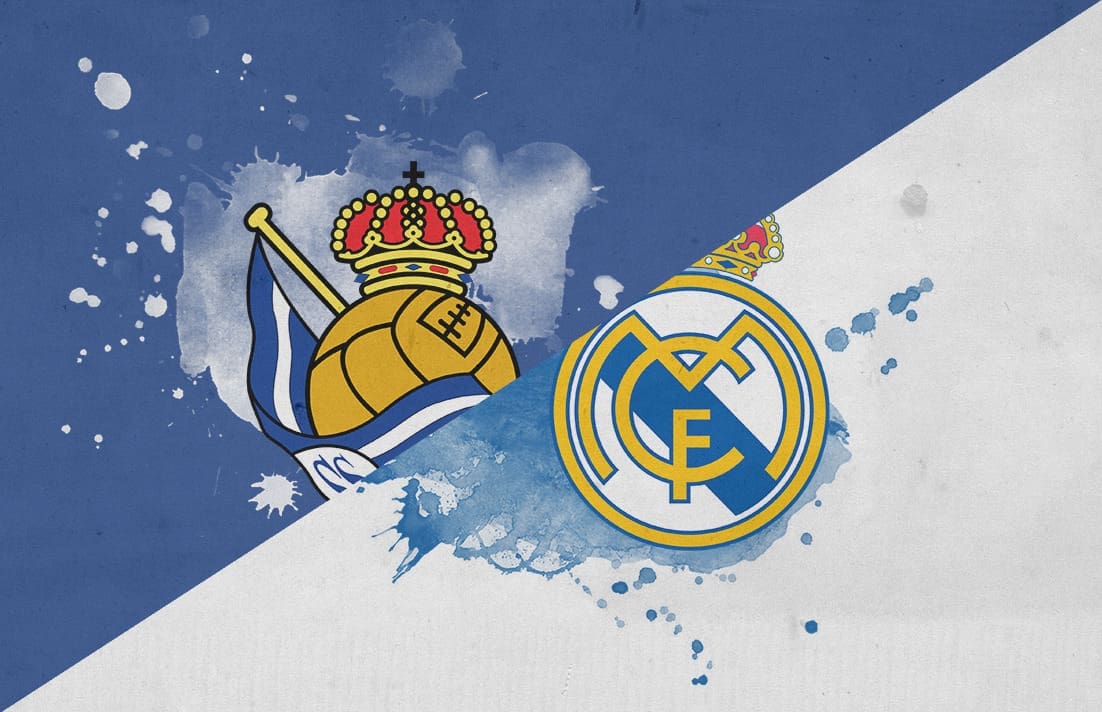



Comments